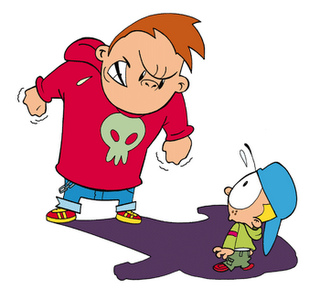What Is the Definition of Bullying?

“Bullying is when you keep picking on someone because you think you’re cooler, smarter, stronger or better than them.”
How did we come up with this definition?
Let’s start with the basics. What exactly is the definition of bullying? Unfortunately there are as many definitions of bullying as there are people talking about it. One definition of bullying of kids is:
Bullying is a form of proactive aggression in which the bullying is unprovoked and the bully initiates the bullying behaviour. (Dodge and Coie, 1987)
Another is:
Bullying involves an imbalance of power between the bully and the victim, is intentionally harmful and occurs repetitively. (Olweus et al., 1999)
A great definition of bullying for kids from stopbullying.gov that incorporates elements of both of these bullying definitions is:
Bullying is unwanted, aggressive behavior among school aged children that involves a real or perceived power imbalance. The behavior is repeated, or has the potential to be repeated, over time. Bullying includes actions such as making threats, spreading rumors, attacking someone physically or verbally, and excluding someone from a group on purpose.
To put this into a more kid-friendly definition of bullying, you could say that:
Bullying is when you keep picking on someone because you think you’re cooler, smarter, stronger or better than them.
Repetition and an Imbalance of Power Make Bullying Unique
There are two components in the above definitions of bullying for kids that make bullying unique.
- Bullying is a repetitive act that occurs over time. This differentiates bullying from aggressive acts that occur only once.
- Bullying involves an imbalance of power between the bully and the victim.
Of course, bullies need not be physically stronger than their victims. Instead, this imbalance of power that occurs in bullying can come from numerous sources including:
- Being more popular
- Being stronger
- Being smarter
- Having a higher social status
Types of Bullying
Bullies, Victims & Bully-Victims: The Problem with the Bully and Victim Labels
Not all victims of bullying play the role of victim their entire time in school. Similarly, not all bullies play the role of bully their entire time in school. In fact, one study done on a middle school showed that 87% of students changed their role over the course of 3 years (Swearer, Cary, & Frazier-Koontz, 2001.)
What’s more, a size-able portion of students are both bullied and play the role of bully themselves creating a third category – the bully-victim. In comparison with bullies and victims, bully-victims are at increased changes of developing mood-related disorders like depression and anxiety.
Susan Swearer in her book, Bullying Prevention and Intervention: Realistic Strategies for Schools, suggests that people adopt a terminology that allows for the fact that students can and do move between the roles of bully & victim. Specifically, she recommends using the terms ‘students who bully’ and ‘students who are victimized’.
Find out about Interesting Facts About Bullying for Kids
References for the Definitions of Bullying
- Dodge KA, Coie JD. Social-information-processing factors in reactive and proactive aggression in children’s peer groups. J Pers Soc Psychol. 1987;53:1146–1158
- Olweus, D., Limber, S. P., & Mihalic, S. (1999). The Bullying Prevention Program: Blueprints for Violence Prevention, Vol. 10. Center for the Study and Prevention of Violence: Boulder, CO.

